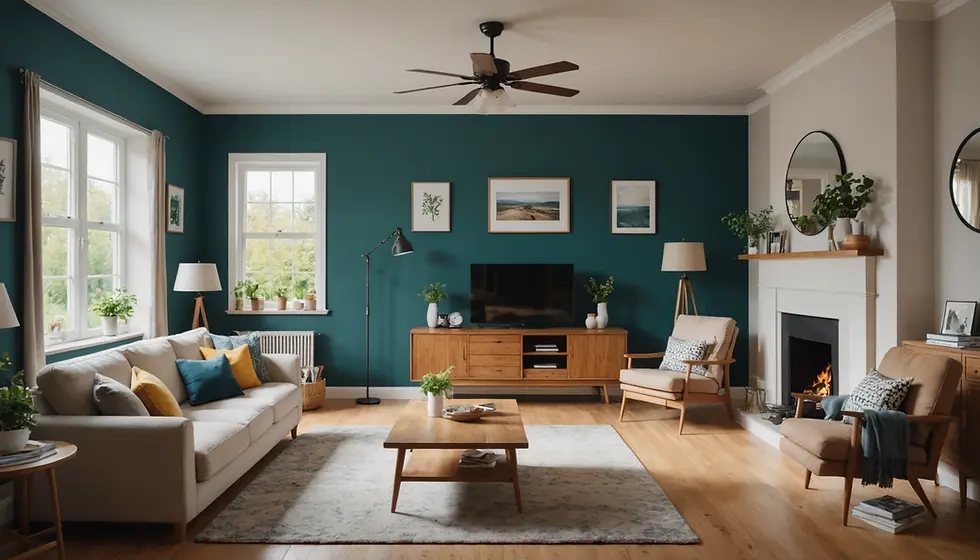EXPERT OPINION ON PLANNING & DESIGN OF STANDARD INTERIOR DESIGN
- SILA

- Jan 27
- 4 min read
Interior design shapes how we perceive and enjoy our everyday surroundings. It not only reflects personal tastes but also significantly impacts our mood and productivity. A well-planned interior can make us feel more at ease, inspired, and even energized. This blog post discusses key principles of standard interior design and planning, providing insights to help you craft an attractive and functional space.
Understanding Standard Interior Design
Standard interior design includes the established practices guiding the layout and visuals of interiors. Whether you are planning a home, a store, or a public area, knowing these principles is essential.
Interior designers use these standards to blend functionality with visual appeal. Key factors such as dimensions, colors, and textures are considered when creating a cohesive look that satisfies its users.
One notable trend is the open-floor plan, facilitating adaptable spaces. For instance, many homeowners are incorporating kitchen-dining-living combos, making over 60% of their living area multifunctional.
Key Elements of Interior Planning
Space Planning
Good space planning is foundational to successful interior design. It requires understanding how spaces will function and creating layouts that support these uses.
For both residential and commercial spaces, planners begin by measuring room dimensions and mapping out furniture placement and pathways. For example, a well-thought-out layout in a 200-square-foot studio can maximize the use of space, creating a comfortable living area that retains style.
Every space serves different purposes and must meet its occupants' needs. In designing a child's room, you might dedicate 60% of the area for play and the rest for storage, ensuring that toys are easily accessible yet neatly organized.
Color Schemes
Color schemes greatly influence our feelings and perceptions. Choosing the right palette is important for the atmosphere.
Neutral colors tend to create a serene effect, while bold hues can energize a room. A study showed that rooms in light blue tones boost creativity by 25%, making it a perfect choice for workspaces or areas for brainstorming.
Remember to consider how colors change under different lighting conditions. A creamy white wall may appear warmer in the morning light but cooler in the evening.
Lighting Design
Lighting can transform spaces remarkably. It highlights attractive features and ensures functionality.
Maximize natural light wherever possible. For example, a room with large windows can feel up to 15% larger when well-lit. Where natural light is limited, use layers of artificial lighting, such as ambient, task, and accent lights to create a balanced feel.
Incorporating dimmers allows for flexibility, adjusting brightness according to activities and moods. For example, soft lighting works well for an evening gathering, while bright light is essential for reading or cooking.
Furniture Selection and Arrangement
Selecting the right furniture is vital for an inviting and practical design. Consider aesthetics alongside comfort and functionality.
How you arrange furniture affects the overall feel of a space. A layout that encourages conversation can make a room more inviting. For instance, placing a sofa facing a couple of armchairs creates a cozy conversation area while allowing movement between spaces.
Using standout pieces, like a stylish sofa or a distinctive coffee table, can enhance the room's visual flow and focus.
Incorporating Textures
Textures contribute depth and warmth to interiors. Blending materials like wood, metal, and textiles can create a visually captivating environment.
In standard interior design, the balance of textures is intentionally planned to express a particular style. For example, pairing soft leather cushions with a rugged wooden coffee table can create an inviting atmosphere. A room that combines various textures may feel more dynamic and engaging.
Consider how textures impact mood; a room filled with soft textiles may feel cozy, whereas smoother, minimalist surfaces may impart a modern, clean vibe.
Personal Style vs. Standard Design
While it's essential to follow standard design principles, infusing personal style into the process is equally important. Spaces should mirror the inhabitants' personalities.
Simple touches like unique artworks or personal accessories can provide warmth and character to a standard design. Incorporating specific items, such as a family heirloom or a piece from a memorable trip, can personalize the space while adhering to established design standards.
Striking a balance between personal style and standard practices results in an inviting environment that feels true to its inhabitants.
Sustainability in Interior Design
Sustainable design is a growing trend, driven by awareness of environmental conservation. Many consumers now seek designs that are both visually appealing and eco-friendly.
Sustainable practices include using materials from renewable sources and opting for energy-efficient appliances and lighting. For example, LED lights can reduce energy costs by up to 75% compared to traditional bulbs while lasting 25 times longer.
Embracing sustainable design not only benefits the planet but also enhances a space’s overall health and efficiency.
Final Thoughts
Applying the principles of standard interior design can lead to spaces that are functional, stylish, and reflective of your personality. Key aspects include effective space planning, thoughtful color selection, lighting design, furniture arrangement, and texture integration.
As interior design evolves with trends focusing on sustainability and personalization, one thing remains clear: having a thoughtful approach to design enriches our living experience. By thoughtfully balancing these components, you can create environments that fulfill your needs and stand the test of time.

Transforming your interior is a journey. Use these principles as a guide, and start enhancing your space today!



Comments